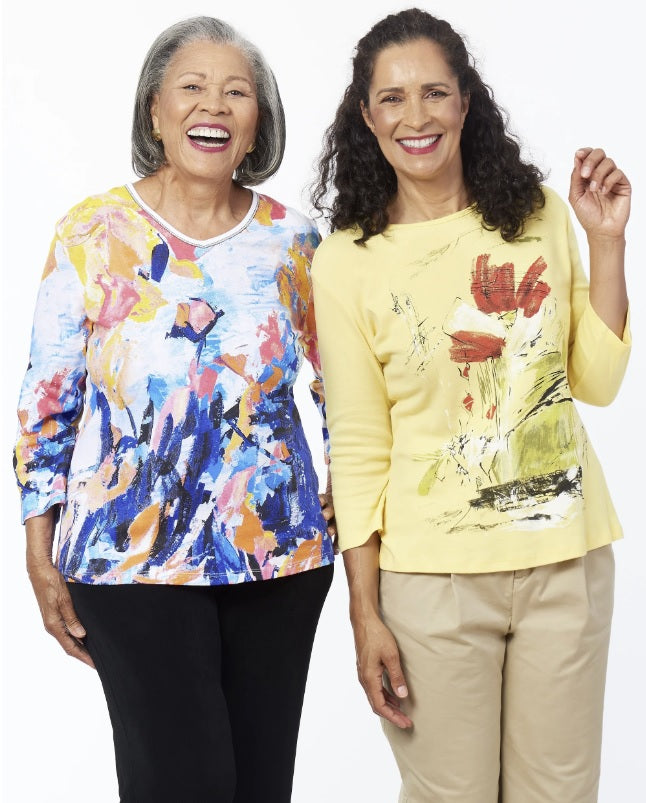Your Cart is Empty
Bill Resident Trust Accounts! Spring Fashions & Colors Now In Stock!

Adaptive clothing, specifically designed to meet the unique needs of senior and disabled individuals, offers a range of benefits that enhance comfort, independence, and overall well-being. By incorporating functional modifications and innovative design elements, adaptive clothing addresses the challenges faced by individuals with limited mobility or disabilities. This essay explores the numerous advantages of adaptive clothing, highlighting its positive impact on seniors and disabled individuals.
Promoting Independence: One of the key benefits of adaptive clothing is its ability to foster independence among seniors and disabled individuals. By featuring easy-to-use closures, such as Velcro fasteners, magnetic buttons, or elastic waistbands, adaptive clothing simplifies the process of dressing and undressing. This allows individuals to maintain a sense of control over their daily routine, reducing their reliance on caregivers or family members for assistance. Independence in dressing promotes self-esteem and enhances the overall quality of life for seniors and disabled individuals.
Enhancing Comfort: Adaptive clothing is designed with comfort in mind. Soft, breathable, and stretchable materials are used to ensure maximum comfort throughout the day. These garments often feature seamless designs and tagless labels to minimize skin irritation. Additionally, adaptive clothing accommodates various body shapes and sizes, providing a relaxed and non-restrictive fit. By prioritizing comfort, adaptive clothing allows seniors and disabled individuals to enjoy their daily activities without discomfort or unnecessary physical strain.
Simplifying Dressing Challenges: Many seniors and disabled individuals face specific dressing challenges due to limited mobility, dexterity, or cognitive impairments. Adaptive clothing addresses these challenges through innovative design elements. For example, open-back designs or side-fastening pants facilitate dressing for individuals who have difficulty raising their arms or bending at the waist. Similarly, adaptive footwear with wider openings or adjustable closures simplifies the process of putting on and taking off shoes. By eliminating barriers to dressing, adaptive clothing empowers individuals to maintain their personal style and independence.
Enhancing Safety: Safety is a significant concern for seniors and disabled individuals. Adaptive clothing incorporates features that mitigate potential risks. Anti-slip soles on footwear provide stability and reduce the likelihood of falls, while flame-resistant materials offer protection in case of accidents. Additionally, adaptive clothing can include reflective elements, enhancing visibility and ensuring the wearer's safety in low-light conditions. By prioritizing safety, adaptive clothing provides peace of mind to both individuals and their caregivers.
Preserving Dignity and Self-esteem: Maintaining dignity and self-esteem is crucial for the well-being of seniors and disabled individuals. Adaptive clothing plays a vital role in preserving these aspects. By offering clothing options that are fashionable and in line with personal style preferences, adaptive clothing allows individuals to express themselves confidently. The garments are designed to conceal any functional modifications, ensuring that the focus remains on the individual rather than their disabilities. This fosters a positive self-image and promotes a sense of dignity and self-worth.
Assisting Caregivers: Adaptive clothing not only benefits seniors and disabled individuals but also provides relief to caregivers. The ease of dressing facilitated by adaptive clothing reduces the time and physical effort required for caregiving tasks. This allows caregivers to allocate their time and energy more effectively, focusing on other aspects of care provision. By streamlining the dressing process, adaptive clothing positively impacts both the individuals and their caregivers, fostering a more balanced and efficient caregiving environment.
Conclusion: In conclusion, adaptive clothing plays a vital role in enhancing the lives of senior and disabled individuals. Through its thoughtful design and functional modifications, adaptive clothing promotes independence, comfort, and safety. By addressing the challenges associated with dressing, it empowers individuals to maintain their personal style and dignity. Moreover, adaptive clothing offers invaluable assistance to caregivers, simplifying their responsibilities and reducing physical strain. As the demand for inclusive and accessible clothing continues to grow, the benefits of adaptive clothing for seniors and disabled individuals cannot be overstated. It is a testament to the power of innovation and design in creating a more inclusive and compassionate society.